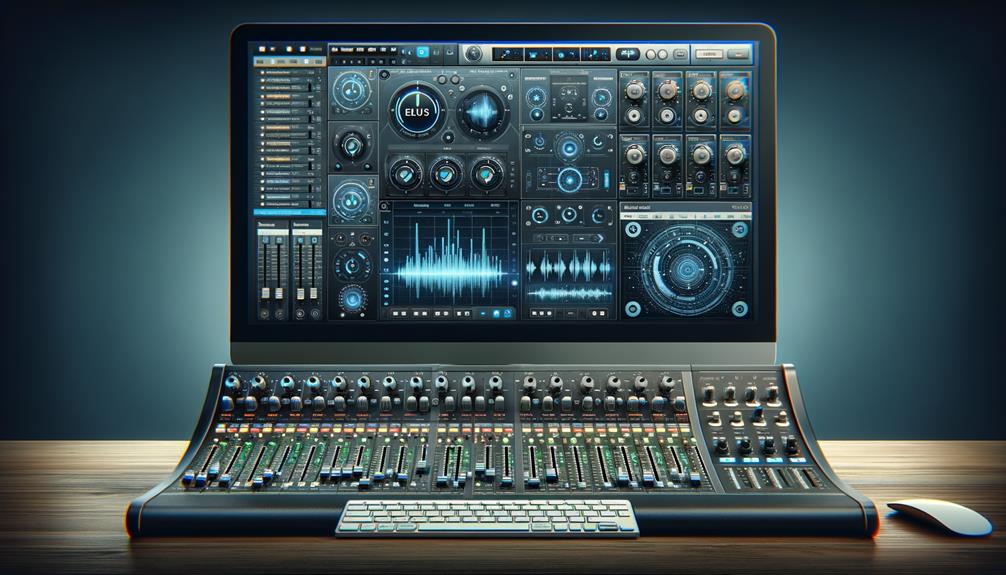To export an MP3 from Logic Pro X, start by ensuring your project is finalized. Navigate to the “File” menu and select “Bounce,” then choose “Project or Section.” In the Bounce window, select MP3 as the format and set the bit rate to 320 kbps for ideal quality. Choose a suitable folder and name the file for easy identification. After exporting, conduct playback tests to verify the audio quality. Finally, consider uploading your MP3 to platforms like SoundCloud or Bandcamp to share your music. Further insights and tips can enhance your export and sharing process.
Key Takeaways
- Ensure your project is fully prepared with mixed tracks and proper sample rate and bit depth settings before exporting.
- Navigate to the “File” menu, select “Bounce,” and choose “Project or Section” for the export process.
- In the Bounce window, select “MP3” format and set the Bit Rate to 320 kbps for high audio quality.
- Choose a suitable folder for saving the exported MP3 file and name it descriptively for easy identification.
- Conduct playback testing post-export to verify the audio quality of the MP3 file.
Preparing Your Project
Before initiating the export process, it is essential to confirm that your project is fully prepared, as even minor oversights can compromise the final output.
When preparing your project in Logic Pro X, make sure all tracks are mixed and edited to achieve peak sound quality. Verify the sample rate and bit depth in the project settings, ideally set to 44.1 kHz or 48 kHz and 16-bit or 24-bit, respectively, to guarantee compatibility with the MP3 format. Proper mastering techniques, such as equalization and compression, can significantly enhance the sound quality of your final export.
Select the specific audio region for export using the cycle range tool or by manually defining the range in the timeline.
Finally, save your project and create a backup, while cleaning your workspace by muting or hiding any unnecessary tracks that could interfere with your desired output.
Initiating the Export Process
To initiate the export process in Logic Pro X, first select the desired audio region within your project.
Then, navigate to the menu bar, click on “File,” and choose “Bounce” to access the Bounce window.
Here, you can define the export range and proceed to set your MP3 format preferences.
Selecting Audio Region
Begin the export process in Logic Pro X by selecting the desired audio region within the workspace. To do this, click and drag over the section you wish to export.
Alternatively, you can utilize the Cycle Range tool, which highlights the selected area with a yellow range on the timeline.
Verify that any unwanted tracks are muted to avoid including them in the export, which can impact your final audio quality.
If you need to export multiple sections, hold the Shift key while selecting additional audio regions.
Once your selections are complete, you will be positioned to move on to the next steps in the export process.
Accessing Bounce Menu
Having selected the desired audio region, the next step involves accessing the Bounce menu to initiate the export process. Follow these steps to proceed efficiently:
- Navigate to the File menu and click on Bounce.
- Select Project or Section to specify whether you want to export the entire project or only a selected segment.
- In the Bounce window, choose your desired audio format, including MP3.
Ensure that the output range is accurately defined using the cycle range or by manually inputting the section you wish to export.
After confirming your settings, click the Bounce button to finalize the export.
This streamlined process allows for a precise and effective way to export your audio project.
Selecting MP3 Format
When selecting the MP3 format in Logic Pro X, it is important to navigate to the Bounce window and choose “MP3” from the destination format options.
Verify that “MP3” is highlighted in blue; this allows access to additional parameters specific to MP3 exports. This customization is essential for achieving better audio quality in your MP3 files.
Before proceeding, confirm your selection of the MP3 format and any desired settings. This step is critical to prevent quality issues in your final output.
Once satisfied, review the settings in the Bounce window, particularly focusing on the Bit Rate. Setting the Bit Rate to 320 kbps will enhance the audio quality, making it ideal for music sharing and streaming. Additionally, understanding the cost structures of mastering services can help you make informed decisions about your overall audio production budget.
Setting the Bit Rate
To guarantee ideal audio quality in your MP3 export, it is essential to set the appropriate bit rate within the Bounce window of Logic Pro X. The bit rate directly influences the audio fidelity of your file format, balancing sound quality and file size.
Consider the following options when selecting your bit rate:
- 320 kbps: High-quality sound reproduction with larger file size.
- 192 kbps: Moderate quality, offering a balance between audio clarity and smaller file size.
- 128 kbps: Lower quality, suitable for minimal file size but compromises audio quality.
Always confirm your selected bit rate before finalizing the export to guarantee it meets your requirements for bit depth and audio quality. Additionally, selecting the right mastering techniques ensures that your final mix translates well across different playback systems.
Finalizing the Export
Once you have configured the necessary settings in Logic Pro X, finalizing the export is a straightforward process that guarantees your audio file is ready for distribution.
Start by selecting the desired section of the audio file, then navigate to the menu and click on “File,” followed by “Bounce” to open the Bounce window.
Verify “MP3” is selected as the destination format, confirmed by its blue highlight. Set the “Bit Rate Stereo” to “320 kbps” for peak quality.
Click “OK,” and a prompt will allow you to choose a folder for saving the exported MP3 file.
Remember to name the exported file descriptively for easy identification, ensuring it meets your quality standards before distribution.
Verifying File Quality
After completing the export process, verifying the quality of the MP3 file is crucial to guarantee it meets professional standards. This involves several critical steps in music production:
- Playback Testing: Play the MP3 file on various devices, such as smartphones, computers, and professional audio systems, to guarantee consistent sound quality across different playback environments.
- Audio Analysis: Utilize audio analysis tools to assess frequency response and dynamic range, confirming that the exported files meet your quality benchmarks.
- Comparative Listening: Conduct a listening test by comparing the exported MP3 with the original project file to detect any significant quality loss. Additionally, ensure that the audio is free from background noise for an optimal listening experience.
Furthermore, check that the MP3’s metadata is accurately filled out for proper identification.
These steps are crucial for verifying file quality in Logic Pro X.
Uploading and Sharing
After exporting your MP3 file from Logic Pro X, the next step is to upload it to a digital distribution platform, such as DJ Pool.
Verify that your file adheres to the platform’s specific requirements, including format and bitrate, before initiating the upload process.
Once uploaded, you can share the MP3 across social media or use it in DJ sets to maximize your audience engagement.
Digital DJ Pool Uploads
Uploading MP3 files to Digital DJ Pool requires attention to format specifications and platform compatibility.
To guarantee a successful upload, follow these essential steps:
- File Format: Confirm that your tracks as audio files are in MP3 format, adhering to bitrate and quality standards.
- Metadata Input: During the upload process, provide necessary metadata such as track title and artist name to enhance visibility.
- Verification: After uploading, check for confirmation messages to verify that your MP3 has been successfully submitted.
Social Media Sharing
How can artists effectively share their music with a broader audience? Once your MP3 file is saved, utilize social media platforms like Facebook, Instagram, and Twitter for sharing. To upload your MP3 files, leverage platforms such as SoundCloud or Bandcamp, making sure the file meets their requirements. Engage your audience by incorporating visuals and album artwork.
Here’s a table to guide your sharing process:
| Action | Platform | Tips for Success |
|---|---|---|
| Click Upload button | SoundCloud | Use genre-specific hashtags |
| Use New Folder button | Bandcamp | Verify file size is ideal |
| Share on social media | Facebook/Instagram | Post engaging visuals |
| Tag relevant accounts | Engage with followers | |
| Monitor feedback | All platforms | Adjust strategy accordingly |
Frequently Asked Questions
How to Export MP3 in Logic Pro X?
To export MP3 in Logic Pro X, configure logic settings to guarantee ideal export quality. Select the appropriate file formats, adjust audio mixing parameters, and finalize the export to achieve a professional audio output suitable for distribution.
What’s the Difference Between Bounce and Export?
The bounce process consolidates multiple tracks into a single audio file, applying effects, whereas export settings allow for individual track retrieval in various audio formats, enhancing project management and facilitating collaboration without altering original audio characteristics.
How Do I Convert WAV to MP3 in Logic Pro X?
To convert WAV to MP3 in Logic Pro X, utilize the software’s export functionality. This process guarantees ideal MP3 quality while maintaining audio integrity, providing enhanced software compatibility across various platforms compared to traditional WAV benefits.
How Do I Export Sheet Music From Logic Pro X?
To export sheet music from Logic Pro X, select the desired MIDI region, access the print dialog, adjust settings for sheet music formats, and utilize notation software or music transcription tools for maximum fidelity and accuracy.
Conclusion
In summary, exporting an MP3 file from Logic Pro X involves a systematic approach that includes preparing the project, initiating the export process, selecting the appropriate format, and adjusting the bit rate. Finalizing the export and verifying file quality guarantee the desired results are achieved. Once these steps are completed, the MP3 file can be successfully uploaded and shared. Mastery of this process enhances audio production efficiency and enables effective distribution of sound projects.



